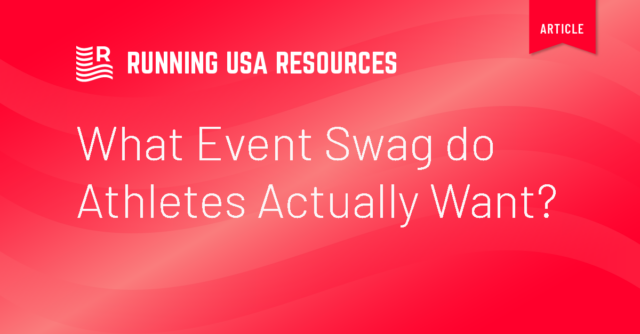by Kelly O’Mara
The 2022 Running USA Global Survey found that 16% of respondents consider the medal or finisher award when choosing a race. Sure, the main concern is the distance and course, race location, and if their friends are doing it, but runners are also all about the bling.
And after you spend all that time designing, ordering, and buying merch, you want the runners to actually like and wear it—not just throw it in a box or on a shelf never to be seen again.
“Every athlete is going to be different in their preferences,” said Kate Boughner, an account manager with Running Awards & Apparel. Some people hate cotton t-shirts, some can’t stand long-sleeves, but there are still some overall trends she’s been seeing in the swag industry.
T-shirts & medals
Before the pandemic, Running Awards & Apparel focused on providing lots of different items—keychains, beer koozies, rally towels, you could put your logo on anything. But since in-person events have been returning, Boughner said they’ve re-prioritized their focus on the most popular items: really nice shirts and custom medals.
Lots of runners—especially if your event attracts first-timers or is a culminating achievement of a major training plan—consider the medal or finisher award when signing up for races. So designing medals “that are enticing, exciting, or different,” is important, said Boughner. That can include things that incorporate the theme of the race — color runs with lots of colors or wood medals for trail runs — or medals that fit together for a whole series of races — such as a design that runs across three or four events or pieces that fit together to make up a bigger medal. It can include engraved or printed medals, even a style of printing that allows photo-quality images, 3D medals, spinners or danglers, bottle openers for post-race beers. You can even have the medal simply be a metal cup that gets filled up with a post-race beer upon finish (depending, of course, on the event).
Custom medals can cost anywhere from $2/medal for basic mass orders to $7/medal for custom large designs.
There are also sustainable options made out of wood (perfect for trail races), recycled bike parts (popular for cycling events), edible awards that can be eaten, prizes like customized water bottles or jewelry instead, or sustainable medals that can be planted and turned into flowers or trees. More and more race directors are getting creative.
While medals will typically get hung up on a wall or put on a shelf after the event is over, race shirts are often viewed as an additional branding or advertising item that athletes can wear around to promote the event. To that end, it’s key to make something that athletes will actually wear.
Boughner said that’s partially why they’re seeing a trend moving away from the technical running materials, which were popular with race shirts the last 10 years, and more towards softer blend materials that can be worn in more situations. “Something you might throw on with jeans and wear all day,” she said.
There are now cotton/polyester blends that offer a mix of technical advantages and are softer and more trendy. Think athleisure lifestyle clothing.
Gone are the days of thick 100% cotton unisex t-shirts. In the age of custom clothing, most runners are not happy if they get an overly large, ugly cotton t-shirt. It’s also important to consider your gender mix. Most female runners have come to expect women’s-specific shirts—though that does not necessarily have to mean pink it and shrink it. Women’s styles have moved away from overly fitted tight t’s. Consider your audience and runner base as you design a shirt option.
T-shirt prices can run from $6-7 up to $20, depending on the type of printing you use, how many colors, material, and long-sleeve or short-sleeve. With supply chain issues, it’s important to reach out and start your order at least three months in advance of your race—especially if you don’t have a design ready. Predicting sizes and order numbers is, of course, one of the most challenging aspects of ordering swag, especially for first year races. A good rule-of-thumb is to set a cut-off date where athletes are only guaranteed a shirt if they sign up by a certain time (you can still add 10-15% to your t-shirt order to cover any late registrations).
Other things to consider
That same 2022 Running USA Global Survey, however, found that 57% of runners said they wished races offered something other than just a finisher t-shirt, and a growing number of athletes (especially younger runners) have said in various market trend studies and post-race surveys that sustainability is important to them.
To that end, the more creative you can get the better.
More events are now offering the choice for runners to opt out of the t-shirt for a slight discount or to donate that money (which can still save you money as an RD if it’s less than the shirt would have cost) or to plant a tree instead of get a t-shirt. There’s also a boom in what would be considered VIP or higher quality experiences and merchandise, which can mean offering the option instead to upgrade to a nice jacket or well-made half-zip. Giving runners the option to purchase a higher quality sweatshirt they might actually wear or a beanie or a bag can be a good alternative to a included cheap t-shirt.
The other most popular items Boughner says they see are hats, especially running technical hats and popular among triathletes, or bags, whether simple canvas or duffle gym bags.
But keep in mind: You’re the race director, so in theory you know who your runners are and what you would want. What are you seeing? Everyone was wearing bucket hats at the hot trail races this past summer, so a branded bucket hat could be perfect instead of a t-shirt for a hot summer event.
Boughner recommends considering your race and your runners, specifically. “Think about what type of runner you might be appealing to,” she said. For example, a school 5K probably shouldn’t use pint glasses as a swag item. You want the design and specific item to fit with your theme. Another example: the Nike women’s half-marathon used to give out Tiffany’s necklaces instead of medals, which were so popular it attracted runners just for the necklace (which were also handed out by the city’s volunteer firemen at the finish line…)
What don’t runners like? They don’t like things that are repetitive year-to-year, said Boughner. They don’t like things they won’t actually use or enjoy. Be unique, enticing, fun, and tied to the values of your race and your community.
About the Author
 Kelly O’Mara is the former editor-in-chief of Triathlete Magazine and the founder of the Triathlonish
Kelly O’Mara is the former editor-in-chief of Triathlete Magazine and the founder of the Triathlonish

